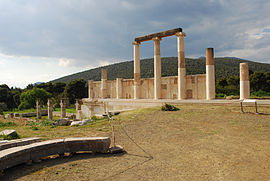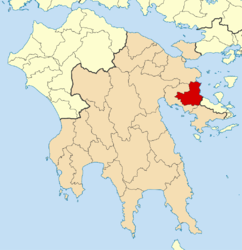Epidavros
|
Epidaurus Επίδαυρος |
|
|---|---|

Abaton of Epidaurus
|
|
| Coordinates: 37°38′N 23°08′E / 37.633°N 23.133°ECoordinates: 37°38′N 23°08′E / 37.633°N 23.133°E | |
| Country | Greece |
| Administrative region | Peloponnese |
| Regional unit | Argolis |
| Area | |
| • Municipality | 340.4 km2 (131.4 sq mi) |
| • Municipal unit | 160.6 km2 (62.0 sq mi) |
| Population (2011) | |
| • Municipality | 8,115 |
| • Municipality density | 24/km2 (62/sq mi) |
| • Municipal unit | 3,887 |
| • Municipal unit density | 24/km2 (63/sq mi) |
| Community | |
| • Population | 1,932 (2011) |
| Time zone | EET (UTC+2) |
| • Summer (DST) | EEST (UTC+3) |
| Vehicle registration | AP |
 |
|
| UNESCO World Heritage Site | |
|---|---|
| Location |
Greece |
| Criteria | i, ii, iii, iv, vi |
| Reference | 491 |
| Coordinates | 37°35′46″N 23°4′45″E / 37.59611°N 23.07917°E (theatre) |
| Inscription | 1988 (12th Session) |
|
[]
|
|
Epidaurus (/ˌɛpɪˈdɔːrəs/; Ancient Greek: Ἐπίδαυρος, Epidauros) was a small city (polis) in ancient Greece, on the Argolid Peninsula at the Saronic Gulf. Two modern towns bear the name Epidavros (Modern Greek: Επίδαυρος): Palaia Epidavros and Nea Epidavros. Since 2010 they belong to the new municipality of Epidaurus, part of the regional unit of Argolis. The seat of the municipality is the town Lygourio.
Epidaurus was independent of Argos and not included in Argolis until the time of the Romans. With its supporting territory, it formed the small territory called Epidauria. Reputed to be founded by or named for the Argolid Epidaurus, and to be the birthplace of Apollo's son Asclepius the healer, Epidaurus was known for its sanctuary situated about five miles (8 km) from the town, as well as its theater, which is once again in use today. The cult of Asclepius at Epidaurus is attested in the 6th century BC, when the older hill-top sanctuary of Apollo Maleatas was no longer spacious enough.
...
Wikipedia



